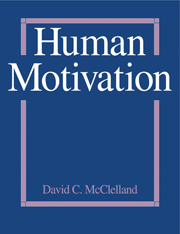Book contents
- Frontmatter
- Preface
- Foreword
- Contents
- Part 1 Background
- 1 Conscious and Unconscious Motives
- 2 Motives in the Personality Tradition
- 3 Motivation in the Behaviorist Tradition
- Part 2 The Nature of Human Motives
- Part 3 Important Motive Systems
- Part 4 Contextual Effects on Human Motives
- Bibliography
- Acknowledgments
- Index
3 - Motivation in the Behaviorist Tradition
Published online by Cambridge University Press: 05 July 2014
- Frontmatter
- Preface
- Foreword
- Contents
- Part 1 Background
- 1 Conscious and Unconscious Motives
- 2 Motives in the Personality Tradition
- 3 Motivation in the Behaviorist Tradition
- Part 2 The Nature of Human Motives
- Part 3 Important Motive Systems
- Part 4 Contextual Effects on Human Motives
- Bibliography
- Acknowledgments
- Index
Summary
• THORNDIKE'S STUDIES OF ANIMAL MOTIVATION
At the very moment Freud was discovering the motives behind the dreams of his patients in Vienna, psychologists in the United States were pursuing a radically different approach to understanding motivation. They felt that reports of inner states of mind were unreliable and therefore could never form the basis of an objective science of psychology patterned after the natural sciences. The idea is nicely expressed in a recent physiology textbook (Vander, Sherman, & Luciano, 1975): “Conscious experiences are difficult to investigate because they can be known only by verbal report. Such studies lack objectivity … in an attempt to bypass these difficulties scientists have studied the behavioral correlates of mental phenomena in other animals.”
It was this line of reasoning that led the U.S. psychologist Edward L. Thorndike to begin studies of motivation and learning in kittens, dogs, and chickens in the 1890s. He placed animals in boxes made out of orange crate slats with a door that opened when a string was pulled or a button inside was turned from the vertical to the horizontal position.
- Type
- Chapter
- Information
- Human Motivation , pp. 68 - 104Publisher: Cambridge University PressPrint publication year: 1988

